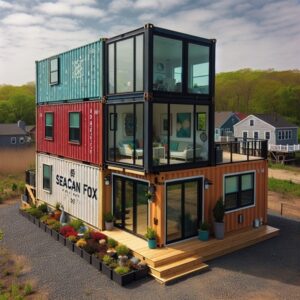Key Takeaways
- Understand California’s specific zoning and building codes for container homes.
- Learn the steps to obtain the necessary permits for your container home project.
- Discover how to navigate local ordinances and HOA restrictions.
- Recognize the importance of environmental and safety considerations in your design.
- Get the scoop on the different regulations for container homes versus container offices.
Unlocking the Mysteries of Shipping Container Homes in California
Imagine a home that’s not only unique and stylish but also eco-friendly and potentially more affordable than traditional housing. That’s the allure of shipping container homes, and they’re gaining traction in California for good reasons. But before you dive in, let’s unravel the legal tape that often ties up these innovative dwellings.
My Favorite Container Homes Resource
I compared the top 3 Container Home Guides
to discover the ultimate resource!
See my top recommendation here
Foundations First: Zoning and Building Codes
Before you start sketching your dream container home, you need to get familiar with the rules. And in California, there are plenty of them. Zoning laws vary by city, and they dictate where you can build your home and what it can look like.
Cracking the Code on Zoning
Most importantly, check the zoning regulations for your desired location. Residential zones, commercial zones, and even agricultural zones have different rules. You wouldn’t want to buy land only to find out you can’t build your container home there.
Therefore, a visit to your local planning department is a must. They’ll tell you what’s possible on your plot. Some areas might welcome your container home with open arms, while others may have restrictions that could cramp your style.
Permit Me to Explain: Building Codes and Permits
Building codes are like the rulebook for construction. They ensure that homes are safe and sound. For container homes, you’ll need to comply with the California Building Standards Code, which includes guidelines for structural safety, fire safety, and more.
Because these homes are not your typical brick-and-mortar dwellings, you might face extra scrutiny. But don’t let that deter you. With the right preparation, getting your project approved is entirely possible.
Plotting Your Path: Permit Procedures
Getting a permit for your container home is like going on a treasure hunt. You need the right map, some patience, and a bit of persistence.
Permitting Puzzle: Piecing Together the Requirements
First, you’ll need a site plan, which is like a bird’s-eye view of your property showing where the home will sit. Then, you’ll need detailed drawings of your container home. Think of it as a blueprint for your vision.
After you’ve got your plans, it’s time to submit them to the city. They’ll review everything to make sure it’s up to code. If it is, you’ll get the green light to start building.
Pro Tip: Hiring a Permit Expediter
Sometimes, the permit process can be as tangled as a bowl of spaghetti. That’s where a permit expediter comes in. They’re like your personal guide through the maze of regulations. They know the shortcuts and can help you get your permits faster.
Besides that, they can also spot potential issues with your plans before they become real headaches. It’s an extra cost, but for many, it’s worth every penny.

Designing with Diligence: Meeting California’s Standards
Your container home needs to be more than just good-looking. It has to meet California’s strict standards for design and construction.
Building with Brains: Following the International Residential Code
The International Residential Code (IRC) is a set of guidelines that most places in the U.S. follow, including California. It covers everything from how deep your foundation needs to be to how many exits you need in case of an emergency.
Adhering to the IRC ensures that your container home is not just creative, but also conscientious and compliant. This means peace of mind for you and safety for everyone who steps foot in your home.
California Dreaming: Unique Building Requirements
California has some special considerations, like earthquakes and wildfires. Your container home needs to stand up to these challenges. This means extra reinforcement for shaking ground and materials that can resist a blaze.
Because of these unique risks, California’s building codes might be stricter than other places. But don’t let that discourage you. These regulations are there to protect you and your investment.
Local Laws and Your Container Home
Every city and county in California has its own set of rules when it comes to building homes, container or otherwise. It’s crucial to understand these local laws because they will directly impact your container home project.
City-Specific Zoning: A Case Study
In
, for example, there’s a push for more affordable housing options, which has opened the door for alternative housing like container homes. However, even within the city, different neighborhoods can have different requirements, especially in areas with specific design overlays or historical preservation zones.
Therefore, getting to know your local zoning ordinances is as important as choosing the right design for your container home. It’s the difference between a smooth project and one that’s stuck in bureaucratic limbo.
Positioning Your Container Home: The Lay of the Land
Where you place your container on your property isn’t just about the view. It’s about following setbacks, which are rules about how far your home needs to be from property lines, streets, and other structures.
Setbacks ensure that homes aren’t too crowded and that everyone has enough space. They also help keep neighborhoods looking neat and orderly. So, make sure you factor these into your site plan.
Dealing with Deed Restrictions and HOAs
Homeowners Associations (HOAs) and deed restrictions can throw a wrench in your container home plans. They often have rules about what you can and can’t do with your property, and sometimes they’re not too keen on unconventional homes.
HOA Hurdles: How to Jump Over Them
If you’re in an area with an HOA, it’s best to approach them early. Show them your plans and explain how your container home will be an asset to the community. Sometimes, all it takes is a little communication to smooth things over.
Deed Restrictions: Navigating the Fine Print
Deed restrictions are like the rules of a game written on your property’s title. They can limit the type of home you can build, the materials you can use, and even the colors you can paint your house.
To avoid surprises, read your property deed carefully. If there are restrictions that clash with your container home plans, you might need to look for a different plot or seek a variance, which is a special permission to deviate from the rules.
Remember, the journey to
Stay tuned for the second half of this guide, where we’ll delve into the environmental considerations, container homes for different purposes, and more. You’ll be well on your way to making your container home dream a reality in the Golden State.
| Zoning Requirement | Permit Guideline | Source |
|---|---|---|
| Must comply with building codes and zoning requirements | Building permit required | [1][3] |
| Containers must meet safety standards and be free of chemical hazards | Separate permits required for utilities | [2][5] |
| Containers must not have been used for transporting hazardous materials | Must be inspected and verified by a licensed professional | [2][3] |
| Zoning laws vary by location; check local regulations | Consult local zoning office or professional | [1] |
| Containers approved by HCD are accepted for stated occupancy | HCD-approved containers must bear a State of California insignia | [3] |
References:
- https://ceedcivil.com/news/are-shipping-container-homes-legal-in-california-in-2022/
- https://library.municode.com/ca/riverside_county/codes/code_of_ordinances?nodeId=TIT17ZO_CH17.314HOAL_17.314.070DEST
- https://www.monocounty.ca.gov/generalplan/chapter-20-cargo-containers
Building for the Future: Environmental and Safety Standards
California is known for its environmental consciousness, and that extends to building homes. When designing your container home, consider how you can minimize your environmental footprint. This isn’t just good for the planet—it can also save you money in the long run.
Earthquake-Resistant Design: A Must in California
Because California is earthquake country, your container home needs to be built to withstand the shakes. This means securing it to a solid foundation and using materials that can flex without breaking. It’s not just about following the law; it’s about keeping you safe.
Fire Safety: Building with Caution
Wildfires are another reality in California, and fire safety should be a top priority in your container home design. Use materials that are fire-resistant, plan for defensible space around your home, and know the local fire codes. It’s better to be safe than sorry.
Container Homes for All: Adapting to Your Needs
Container homes are versatile. They can be primary residences, guest houses, or even home offices. But the regulations can differ depending on how you use your container.
Home or Office: Know the Difference
If you’re planning to use a container as an office, you might face different regulations than you would for a home. Commercial zoning laws can be stricter, with additional requirements for accessibility and parking. Make sure you understand these differences before you start building.
Temporary vs. Permanent: The Rules Change
- Temporary structures often have a different set of rules than permanent homes. They might not need the same level of foundation or utilities.
- But be careful—just because a structure is temporary doesn’t mean you can skip the permits. Always check with your local authorities.
Whether you’re planning a cozy container guesthouse or a sleek office space, knowing the specific regulations will help you avoid any legal hiccups.

FAQs: Clearing Up Common Confusions
Can I Build a Shipping Container Home Anywhere in California?
Not quite. You need to check the zoning laws for the specific area where you want to build. Some places are more container-friendly than others.
How Long Does It Take to Get a Permit for a Container Home in California?
It varies. If your plans are in order and you’ve dotted all your i’s and crossed your t’s, it could take just a few weeks. But if there are complications, it could take months. Patience is key.
Do Container Homes Appreciate in Value in California?
They can, especially if they’re well-designed and in a desirable location. Like any home, a container home’s value will depend on the real estate market and how well it’s maintained.
What Are the Common Pitfalls in Building a Shipping Container Home?
- Underestimating the importance of zoning and building codes.
- Skipping the permit process or not following it correctly.
- Ignoring local environmental and safety requirements.
- Not engaging with the community or HOA early in the process.
How Does California’s Climate Influence Container Home Design?
California’s varied climate means you need to think about
Building a shipping container home in California is an exciting journey. It’s a chance to create something truly unique while also being mindful of the environment and local regulations. With careful planning and a bit of creativity, you can turn your vision into a reality. So, what are you waiting for? Start planning your container home today!





